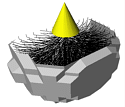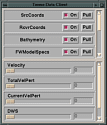2 Motivation
During the execution of a parallel program it is often necessary, for various reasons, for the user to inspect the values of parallel data structures that are decomposed across the processing nodes of a parallel machine. For correctness debugging in a sequential environment, the ability to observe program variables to determine coding errors is a common user requirement; debugging with parallel data objects is no different. Similarly, for interacting with parallel applications (e.g., for computational steering), it may be necessary to access and analyze distributed data at runtime. Also, performance data is typically collected in a distributed manner on each processing node, requiring some mechanism to retrieve the information if it is important for the user to do so during execution.Any tool that addresses a particular user need (whether it be debugging, performance analysis, or application interaction) where distributed data access capabilities are required has either to implement these capabilities itself or rely on some other (open) infrastructure to provide them. In the former case, there are two problems. First, tool implementations tend to become specific to low-level system details. The user-level functionality of the tool may be provided, but platform dependencies may severely hinder its portability. Second, the tool implements only what is necessary for its purposes and abstractions of distributed data access tend not to be developed. This has the effects of limiting tool extension, restricting the ability of other tools to apply the distributed data access support, and leading to inconsistent functionality across tools. The common anecdote from users that "print" is the only good tool is indicative of these two problems: tools for parallel systems are often complex, not integrated, and vary widely across machines. "Print" is the only thing that they can rely on.
The case of relying on some other infrastructure for distributed data access suffers because no such infrastructure currently exists. One might think that "print" provides suitable functionality. But the problem is really the level of the tool's interface to the infrastructure; "print" would require significant scaffolding to give it a high-level interface to an external tool. Similarly, many parallel debuggers are not always aware of how the parallel data structures are distributed. Whereas they provide low-level mechanisms to get the data, the higher-level semantics about what the data is (i.e., the type and characteristics of the distributed data object) are generally not utilized in the infrastructure and are not apparent in its external interface. However, it is exactly these semantics that are helpful in developing open frameworks and portable tools.
The DAQV project highlights the dilemma between the two alternatives above that often face tool designers. Begun as a project sponsored by the Parallel Tools Consortium, DAQV set out to address the user requirement of being able to access and visualize distributed array data coming from a parallel program. Initially, it placed more emphasis on the environment for array interaction (query specifications, array operations, visualization types, etc.) than on the underlying infrastructure for interfacing with the running program. However, based on feedback from the Ptools community [24], it quickly became clear that DAQV's mission was too broad. The most interesting feedback was from users who helped refine the focus of the project towards creating a robust and well-defined infrastructure rather than a multitude of user interface features (as tool designers tend to do). Users made it clear that the most important contribution that the project could make was to provide a technology that lets them "get the data" (a high-level "print" capability, if you will) and use other tools to "work with the data." The goal, then, was to develop interfaces for both (1) low-level extraction of data from the program, and (2) the higher-level request/delivery of data to an external client (e.g., for visualization). Users also acknowledged the importance of HPF as a potential execution target for the DAQV project.
The result is the DAQV tool as described in this paper. We present this background because we feel that the Ptools project evaluation process was instrumental in forcing the design to seriously consider user's needs. This gave DAQV its focus, but how DAQV is built is what makes it unique. DAQV is characteristic not of a tool necessarily, but of a framework that facilitates the development of software for a particular problem area. A framework may generally consist of a set of components with well-defined functions and relationships for constructing the software; templates that can be used to customize functionality or create new components; and user and system interface definitions and modules that allow the developed software to interoperate with other system tools. A framework also may raise the level of developer (user) interaction to hide implementational or operational details, while providing robust backend infrastructure support for targeting multiple platforms. The DAQV framework has all of these features, embodying the requirements of the distributed array access problem in its design and function while keeping flexible and open how the resultant tool is created for a target system. In this way, the DAQV framework truly supports higher-level semantics of data access, and allows extensions both in tool functionality and enhanced data analysis capabilities.
There has been a strong advocation in the last few years for parallel
tools to be more integrated in parallel language systems and to
support the language semantics in their operation. Because a language
system abstracts the parallel execution model to hide low-level system
operation, it is important for users of program analysis, debugging,
and performance tools to be able to work with program objects at the
language level as they seek to understand program structure, behavior,
and performance. For instance, the research work integrating Pablo
with the Fortran D compiler [1] and Tau with the pC++ compiler [4]
demonstrates the importance of providing a high-level semantic
context. This is also clearly seen in the Prism [29] environment for
the Connection Machine systems which is, perhaps, the best example of
the ease of use that can come from an integrated tool system. DAQV
clearly follows in this spirit as it bases its entire functionality
and operation on the data distribution semantics of the HPF language
model. But DAQV goes one step further and actually uses the language
system itself for part of its implementation. This was also a feature
of Breezy, a forerunner of DAQV that provided high-level program
interaction for the pC++ system [5].
One of the key programming abstractions found in parallel language
systems is data parallelism-the parallel operation on data that has
been distributed across the processing nodes of a machine. Because
distribution of parallel data is an important factor in the
performance behavior of a program, viewing the data and performance
information in relation to the distribution aids the user in tuning
endeavors. The GDDT tool [21] provides a static depiction of how
parallel array data gets allocated on processors under different
distribution methods and also supports an external interface by which
runtime information can be collected. In the DAVis tool [18],
distribution visualization is combined with dynamic data visualization
to understand the effects of decomposition on algorithm
operation. Kimelman et al. show how a variety of runtime information
can be correlated to data distribution to better visualize the
execution of HPF programs [19]. Similarly, DAQV could provide
distribution information to clients for augmenting views of data
structure and operation. But there is another use of distribution
information, and that is to reconstruct the partitioned data into its
logical shape. The IVD tool [17] uses a data distribution
specification provided by the user to reconstruct a distributed data
array that has been saved in partitioned form. In DAQV's case, this
reconstruction is done, in essence, by the compiled HPF code using the
implicit distribution information passed to the array access function.
The increasing importance of portability and extensibility in parallel
tools has evoked designs following client/server models. The Panorama
debugger [22] demonstrates how the concept of interoperating modules
can lead to increased functionality and generality in debugging
systems. The p2d2 debugger [6] extends this concept considerably in
proposing a full client/server debugging framework with comprehensive
abstractions of operating system, language, library interfaces, and
protocols for distributed object interaction. DAQV is clearly adopting
the client/server approach for similar reasons, but in contrast to
these two particular tools, the functionality is at a higher level,
affording the possibility of layering DAQV on top of systems like
Panorama and p2d2.
The final perspective is one of dynamic program interaction. There has
been a growing interest in runtime visualization of parallel program
and computational steering. Implementing such support raises
interesting systems implementation issues as well as user issues. On
the one hand, runtime visualization for a particular application
domain might be able to utilize domain knowledge to implement a system
meeting certain performance constraints. The pV3 system [12] is a good
example. However, such specialized implementations may be limited when
considering the general runtime visualization problem. DAQV, in many
respects, is a direct descendant of the Vista research [28] since it
embodies many of the same design goals: client/server operation,
automated data access support, runtime operation, structured
interaction. The improvement DAQV offers is in language-level
implementation to increase portability. We believe that this will also
improve DAQV's ability for computational steering. Although Vista was
extended for interactive steering in the VASE tool [9], the steering
operations were still very much dependent on the target
implementation. Supporting steering at the application language level
is a more robust, general solution and is something we have begun to
investigate in DAQV.
Given these design objectives, how should they be addressed in the
development of a DAQV tool? In one scenario, DAQV could just be a
reference design specification that new tools built from scratch for
different target platforms would try to incorporate. Although certain
user requirements might be captured in formal operational and
interface semantics, unanticipated functionality may be difficult to
retrofit to the different tool versions and still maintain a
consistent design model. Alternatively, a DAQV framework could be
defined that provides techniques to accommodate flexibility in
functionality, but provide a common infrastructure for platform
retargetability. In our tools research, we have found that techniques
that support
are important for building effective tool frameworks. Below, we
describe how the design objectives are met in DAQV, as a result of the
framework approach.
The first two items in the list above will be discussed in more detail
in Section 6.3. Compiler-dependent code is limited to two areas: the
yield point procedural interface (see Section 6.1) and the array
access argument-passing interface (see Section 6.3). The amount of
code that is compiler-specific is small, so isolating it is very easy.
In addition, we claim that the DAQV model and architecture of parallel
program interaction is also portable. This model will be described in
more detail in the next section, and the topic of portability will be
revisited in Section 7.2.
The functionality of the push model is the practical solution to the
feedback from the Ptools user group. That is, with minimal additions
to the HPF source code, users can extract the data values of
distributed arrays and visualize them with other tools, never having
to worry about array reconstruction. The push model can be used to
spot check the state of an array or to create animations of data
values over the iterations of a loop. Multiple arrays can be pushed
out of the program to multiple data clients. More details about how
the push model is used will be presented in Section 7.1.
The pull model allows the programmer to repeatedly run an HPF code for
a period of time and then extract data values from the distributed
arrays of interest. Two types of clients are used in the pull
model. Data clients process data values from arrays just as they did
in the push model. In fact, any data client that works in the push
model also works in the pull model because the pull model is layered
on top of the push model. In addition, though, the pull model requires
a control client to direct program execution and to configure and
initiate array transfers to data clients.
Both models support open interfaces for data transfer, allowing new
data clients to be developed. The pull model also supports an open
control interface through which new DAQV control clients can interact
with the program. But perhaps more interestingly, DAQV functionality
can be incorporated into other tools (e.g., a debugger) through this
simple interface.
The primary conceptual difference between the push and pull models is
where the decision to extract an array originates. The names "push"
and "pull" are meant to reflect this difference in perspective. In the
push model, the HPF program itself "pushes" data out, while in the
pull model, an external client reaches in and "pulls" data
out. However, the implementation of these very different conceptual
models is built upon a common infrastructure supported by DAQV. This
will be a large part of the discussion of DAQV's implementation.
The high-level operation of DAQV demands a different method for
interacting with the HPF program than what a HPF debugger can
provide. Our solution is to implement DAQV as a library that is linked
with the HPF object file, creating a procedural interface between the
HPF program and the distributed array server component. A small set of
seven subroutines, described in Table 1, handles initialization,
registration of arrays, configuration of data clients, and data
extraction.
Currently, the DAQV interface subroutines are inserted manually by the
programmer. If the compiler supports it, DAQV routines could be
inserted automatically. For example, PGI's HPF compiler, pghpf,
automatically inserts line- and/or function-level tracing routines
into the HPF source code [26]. By linking in the DAQV library in place
of the default tracing routines, DAQV uses the calls to these routines
as yield points, places in the program where distributed data can be
accessed.
Conceptually, the client/server interface supported by DAQV exists
between the entire HPF program (i.e., all SPMD processes representing
the HPF program) and external data and control clients. From an
implementation viewpoint, however, only the DAQV manager process
operates as the communications server; the other HPF "worker"
processes cooperate with the manager to effect DAQV operations. DAQV
uses a bidirectional event protocol (described in Table 2) between the
HPF server and the data clients, in both the push and pull models. In
the push model, data clients respond to array data transmissions with
a confirmation that signals DAQV to let the HPF code continue
executing (i.e., the data client's reception of the data is
synchronous with program execution). The pull model uses a more
sophisticated event protocol to interact with the control
client. Events that come into DAQV are received only by the manager
HPF process; some mechanism for informing the other HPF processes
about events is needed. Section 6.3 will discuss in detail how event
sharing is accomplished between the manager and worker processes. We
continue here by describing the DAQV protocols and client
requirements.
Control clients must be more sophisticated than data clients in terms
of the events that they must handle. They must accept and/or read the
events listed in Table 2. A C-library has been developed for
supporting event processing; support for other languages (e.g.,
Tcl/Tk) is under consideration. Furthermore, a control client usually
interacts with the user. As part of our work, we have created
command-line and graphical control client interfaces (see
Section 7.1). More importantly, though, we see the DAQV pull model and
the specification of control events as establishing a framework for
other tool developers. In particular, it provides a simple interface
that can be incorporated into other parallel tools to gain high-level
access to distributed data in a flexible and well-defined manner.
The decision to extract an array can come from two places: the HPF
program in push mode (via daqv_push()) or the control client (via a
PULL event). Both of these actions ultimately result in the same
internal DAQV code being invoked. Currently, DAQV determines the
appropriate access function to use based on array rank and element
type, though we plan to extend the control client event protocol to
allow runtime selection of array access functions. It then creates the
calling context for the access routine and invokes it. An array's
dimensions are passed in as arguments, and the subroutine inherits the
distribution for the incoming array. Compiler-specific optimizations
can be built into the access function. In Figure 1, for example, the
array ITMP is used to reduce a data broadcast to a point-to-point
communication on each iteration.
Consider the pull model, and suppose each HPF process has encountered
a daqv_yield() call. Each process separately transfers control to the
DAQV portion of its executable. The manager process immediately
notifies the control client that the HPF program has yielded to DAQV
and then waits for a reply. Meanwhile, the other processes determine
that they are indeed workers and enter into an event sharing loop (to
be explained). Eventually, the manager receives a request from the
control client, say, to pull an array. However, since all HPF
processes must participate in the call to the array access function
(since it is implemented in HPF), the other processes must be notified
of this request and make the "same call" as the manager to the access
function (as required by HPF's SPMD execution semantics). This is done
with a control mechanism called event sharing.
To accomplish this, each worker process calls the daqv_event_share()
routine shown in Figure 2 to get the event information from the
manager. This allows them to update their DAQV event state to be
consistent with the manager's and to function the same as the manager
does based on the events received from the control client. As seen,
DAQV implements this routine using the HPF language.
Each worker process enters this routine with the value of CMD_SUM set
to zero (note that CMD_SUM is passed by reference); the manager
process, however, calls the routine with an integer value
(representing an event code, parameter, or other information) that is
to be shared with the other processes. The routine distributes one
element of the CMD array to each process (workers and manager) on each
processor. Each process initializes its element of the array to the
value with which it entered the procedure. The global sum reduction is
performed, and the result is assigned back to CMD_SUM (as a procedure
side-effect). Because only the manager's initial CMD_SUM value is
non-zero, the new value of CMD_SUM (in every process) at the end of
the reduction is this value, as we want. Now each process can return
to the DAQV code to perform together whatever operation is required
based on the value of CMD_SUM.
This is how event sharing is implemented in DAQV to remain consistent
with HPF execution semantics. It is probably not the obvious solution
when first faced with the problem of sharing information among several
processes, but in the context of DAQV, it is both an elegant and very
portable one.
The sequence of images in Figure 3 was generated by the Dandy data
client (Section 6.2). The displays show the progression toward a
steady state in the two-dimensional array representing the surface to
which a uniform heat source has been applied. These displays were
created using DAQV's push model. Under this scheme, when the program
is executed and reaches the call to DAQV's daqv_config_push() routine,
the Dandy client connects to the HPF/DAQV program. At this point,
execution resumes and the animation of the data values begins. At each
loop iteration, the new array values are sent to Dandy each time
daqv_push() is called. The Dandy interface (not shown in Figure 3)
allows the user to pause/resume the animation and redraw the
display. Dandy automatically determines the range of the data values
and maps them onto a fixed colormap. However, if the viewer wishes to
fix the color range across several iterations, the automatic scaling
feature can be disabled, allowing minimum and maximum values to be set
manually. This feature can also be used to identify outliers or to
identify values beyond a certain threshold. For example, Figure 3(b)
shows values above the specified range as white. As the algorithm
nears convergence, these values move into the fixed data range, as
seen in Figure 3(c).
The same application can also be used with DAQV's pull model. Figure 4
shows several windows from a DAQV session. A prototype control client
interface (lower, in back) supports several DAQV features. A source
code browser allows the viewer to control program execution by simply
double-clicking on the line to which the code should run
next. Alternately, the user may use the controls in the upper left
portion of the control client to specify a number of yield points
(steps) to skip before reporting back. In the upper right portion of
the control client (partially obscured) is a list of arrays in the
program that have been registered with DAQV. In this case, Surface, a
32x32 real-valued array, has been registered twice so that it may be
viewed with two different data clients. The button immediately to the
left of each registered array entry allows the user to select a data
client for visualizing that array. The pull configuration dialog
(lower right) presents a list of preconfigured tools (specifiable in a
resource file) in a list box, but the user may also provide their own
parameters explicitly. Once an array is configured, the "Pull" button
next to its entry in the registered arrays list is enabled. This
button causes a PULL event to be sent to the server and makes DAQV
send the requested array to the appropriate data client. The first
registered array, Surface1, has been mapped to the Dandy client in the
upper left part of the screen. Similarly, Surface2 is being sent to a
more complex, three-dimensional display built in the Viz visualization
environment builder.
Seismic tomography is used to construct 3D images from seismic wave
information recorded by sea-floor seismometers. The technique, similar
to that used in medical CAT scans, uses recorded arrival times of
acoustic energy from explosive sources or earthquakes. Energy from the
sources propagates downward into the Earth and is then refracted back
to the surface by the positive velocity gradient of the crust and
mantle. The travel time of a seismic wave from its source to a
receiver depends on the velocities sampled by the wave along its
path. The computation of velocity structure from travel-times is
achieved by a search of the parameter space, with each evaluation
requiring first a forward propagation of ray paths and then an inverse
calculation.
The basic computation as described, however, is only part of a much
larger analysis process that can take several months. The full
analysis requires extensive, domain-specific input from a
geoscientist. In a sense, the scientist "steers" the generation of the
final model, examining intermediate results to check the validity of
the inputs, establishing parameter values, optimizing the calculation,
testing hypotheses, and determining the robustness of the final
model. The goal of our environment was to support this total process.
To create appropriate support tools, we broke the overall problem
solving process for seismic tomography into a series of seven steps
and generated a list of domain specific requirements for each of those
steps. The primary requirement was a major improvement in
performance. This was initially achieved by a trivial parallelization
of the algorithm and execution on an 8-processor SGI Power
Challenge. Our analysis also yielded two requirements which DAQV
addressed or helped to address: (1) interactive, on-line
visualization; and (2) computational steering. (For more details on
each step and its associated requirements, please see [8].)
Interestingly enough, the need for these capabilities was as much a
result of the performance improvements gained by the parallelization
of the seismology application as it was the scientists desire for a
more robust and flexible analysis environment. In the original
environment, a "run" of the application consisted of a set of
iterations that generated a single model refinement. At the end of the
run (before the application exited), model data was dumped to a file,
reformatted, and imported into a basic 2D visualization tool for
analysis. The seismologists adjusted the constraint parameters of the
model for the next run. When new parameters were determined, the
application was re-executed. This process was acceptable to the
scientists because of the long computation time (about two hours);
on-line analysis would result in significant waiting time for the
scientists. However, in the parallelized version, only six minutes
were required to generate a new model. Suddenly a tighter coupling
between model generation and model evaluation was possible (and
desired)-a coupling that did not require all the separate steps of
saving, reformatting, importing, and analyzing the data, and then
restarting the application. This shift in the computational analysis
bottleneck from model generation to model evaluation demanded that the
evaluation phase be better supported by the environment. That is, a
solution to "close the loop" of the evaluation phase was needed.
The keys to achieving this goal were (1) avoiding writing model data
to files and then reformatting it before visualization and analysis,
(2) allowing the application to remain in an executing state while
model evaluation occurs, and (3) allowing new model parameters to be
communicated back to the (still) executing program for the next set of
iterations. The DAQV framework was well-suited to these needs. Note,
however, that the third item listed above is not something directly
supported by the DAQV framework previously described.
DAQV's simple procedural interface made it easy for the seismologists
to access model data at runtime and pass it to cooperating tools for
analysis. Much of the model analysis was supported by sophisticated 3D
visualizations created in the Viz environment [14] mentioned
earlier. Viz supports rapid visualization prototyping in a system that
can be extended with application-specific visualization
abstractions. Viz was used to build a visualization environment for
the seismic tomography application that acted as both the control
client and several data clients. Any data that Viz used to create
visualizations was obtained or simply delivered through the DAQV
request and delivery protocols. Some examples of the visualizations
made possible by DAQV are shown in Figure 5, while elements of the
control and data client user interfaces are shown in Figure 6.
Getting data out of the seismic tomography application only closed the
model evaluation loop halfway; there was still a need to communicate
the new parameter values back to the running program for the next set
of iterations. These values are derived by the seismologist and the
interactive visualizations provided by Viz. What was needed was a way
to send values back to the application, preferably by the same
mechanisms that were used to get data in the first place (i.e., the
DAQV event interface). The extensible nature of DAQV's framework made
it very simple to incorporate the ability to alter HPF program
variables based on events received from the external control
client. So, at the end of the evaluation phase and when new constraint
parameters were established, the Viz control client simply sent a new
DAQV "steer" event to the server to effect the steering operation on
the program variables.
Similarly, while the DAQV model proposes the use of just one
instrumentation model (push or pull) in a single execution, the
seismographers desired access to both instrumentation models during a
single program execution. That is, there were certain HPF arrays that
the programmers wanted to send out on a regular basis (push model),
and there were some that they only wanted under certain circumstances
(pull model). The DAQV framework was easily adapted to accommodate
this requirement as well.
Using DAQV in this manner, the graphical user interfaces of the
control client (Figure 6) allow the seismologist to specify input
data, constraint parameters, and the run-time options needed to
launch, start, stop, and continue the execution of the program. The
Viz-based data clients let the seismologist turn on and off specific
visualization features to observe the model space, ray path
calculations, and travel-time fields. In this way, the DAQV framework
facilitates a tight coupling between the executing application and
those analytical processes of the seismologists that rely on parallel
program interaction and data visualization.
We believe that the DAQV model (and even parts of its implementation)
can be applied in many situations where distributed data is
involved. For instance, in the pC++ project, we implemented early
versions of the DAQV design [5]. We now intend to retarget the DAQV
reference code to the HPC++ system [15]. More generally, we see no
intellectual difficulties with porting DAQV to SPMD environments where
some runtime means (language or library) for accessing distributed
data exists that can be merged with the model (e.g., SPMD parallel
array libraries, such as P++, built using PVM or MPI).
A good example of data client portability is the IRIS Explorer module
described in Section 6.2, and shown in Figures 7 and 8. Instances of
this module could be used to collect data from any DAQV
implementation. An environment like IRIS Explorer would easily support
collecting and visualizing data from multiple DAQV applications, even
if those applications were implemented in different languages and
running on different machines.
If the Ptools reference platform were to be adopted by a HPF compiler
vendor, there are some possible opportunities for improvement. In
particular, DAQV lends itself nicely to compiler/preprocessor support
for instrumentation. DAQV already utilizes to some extent automatic
instrumentation in the PGI compiler, but one can easily imagine more
sophisticated front-end support for selecting arrays for access
(automatically generating registration, push, and yield code),
enabling and disabling DAQV operation (generating mode, enable, and
disable code), and providing information concerning when arrays are in
and out of scope. Another improvement that an HPF compiler vendor
could provide is in the (possibly automatic) generation of access
functions for distributed arrays. Coding these by hand is not always
easy nor does it always lead to efficient execution. With their
sophisticated program analysis infrastructure, HPF compilers could
perhaps provide more support to the programmer in this
regard. Finally, we have not discussed DAQV's ability to provide
information about the distribution of arrays, concentrating more on
the support for array data access instead. The HPF standard does
provide the ability to get this information through intrinsic
procedures, and DAQV could trivially incorporate the request,
collection, and delivery of this information into its event and/or
data protocols.
As demonstrated in the seismic tomography application, the DAQV
framework does allow distributed data and program variables to be
altered as well as accessed. The ability to extend the event protocol
and include appropriate access functions makes this capability
possible; we intend to do so. As a result, DAQV could be applied to
application scenarios where changing runtime array data or program
control variables is beneficial. We believe that the benefit of the
high-level, semantic-based query provided by DAQV will allow
sophisticated client tools to be developed for interaction with the
runtime data. In particular, we are currently working on extending the
client-side infrastructure so as to facilitate the binding of
distributed array and program variables, as provided by DAQV, with
interactive 3D visualizations of the array data and program control.
3 Related Work
We view the DAQV work as a confluence of research ideas that have come
from the fields of parallel programming languages, parallel tools,
scientific visualization, and distributed computing over the last five
years. Indeed, in some sense, DAQV is an amalgamation of these ideas
in a form that is tempered by strong user requirements and is targeted
to the HPF language domain. Below, we review the related research from
four perspectives of DAQV: language-level parallel tools, distributed
data visualization, client-server tool models, and program
interaction.
4 Design
DAQV attempts to address the general problem of providing high-level
access to parallel, distributed arrays for the purpose of
visualization and analysis. It does this by "exposing" the distributed
data structures of a parallel program to external tools via interfaces
that obviate the need to know about data decompositions, symbol
tables, or the number of processors involved. The goal is to provide
access at a meaningful and portable level-a level at which the user is
able to interpret program data and at which external tools need only
know logical structures. To this end, DAQV has three primary design
objectives:
4.1 Global View of Data
In a language such as High Performance Fortran (HPF), the programmer
views distributed arrays at a global level, which means the programmer
may perform operations on whole arrays and refer to array elements
with respect to the entire array, as opposed to some local piece on a
particular processor. In other words, HPF supports a global name space
[16, 20]. Clearly, a programmer cannot completely disregard the issue
of data distribution, though, and expect the best
performance. Distribution directives allow the programmer to use their
knowledge about the application and advise the compiler on the best
way to distribute data. However, concern for data distribution does
not affect how the programmer references the data. HPF syntax
insulates the user from ever dealing with an array in a distributed
manner, thereby supporting a logical, global view of data. For similar
reasons it is important that DAQV supports a logical, global
perspective when interacting with the user (through external tools).
4.2 Client/Server Model
DAQV is a software infrastructure that enables runtime visualization
and analysis of distributed arrays. It is not a stand-alone
application or tool that performs these tasks itself; rather, it
interoperates with either external tools built specifically for use
with DAQV, or existing tools that have been retargeted or extended to
interact with DAQV. The goal is to incorporate existing visualization
and analysis tools. The feedback we received from the Ptools user
group during design discussions was clear: they did not need another
fancy, self-contained visualization tool. They just wanted improved
facilities for querying and extracting distributed arrays such that
their existing tools could be easily used with this system. To this
end, we logically view the entire HPF program (not individual
processes or processors) as a distributed array server to which these
external client tools connect and then interact with the program and
its data. At issue, though, is how to make HPF's single-program,
multiple-data (SPMD) program execution [20] appear as a single,
coherent distributed array server, and how to simplify as much as
possible the requirements placed on DAQV clients.
4.3 Portability
Another goal in the design of DAQV was to minimize the degree to which
DAQV is dependent on a particular HPF compiler. By targeting the HPF
language in the first place, machine portability is inherent to the
extent that the HPF compiler is. However, portability across HPF
compilers is also important. DAQV primarily accomplishes this in three
ways: key components of DAQV are implemented in HPF, compiler and
runtime systems are utilized, and compiler-dependent code is minimized
and isolated.
5 Functionality
This section will attempt to describe, in general terms, the
functionality of DAQV. As a framework, DAQV addresses concerns from
both tool users and tool developers. Two different operational models,
called push and pull, are supported. These two models differ in the
degree of interactivity available with the HPF program at
runtime. This section will describe these models, how they differ from
one another, and how they address the concerns of users and
developers.
5.1 The Push Model
The push model forms the basis of DAQV and constitutes the simplest
and least intrusive way to access distributed arrays from an external
tool, or data client. The push model is implemented by inserting
simple DAQV subroutine calls into the HPF source code. These calls
allow the programmer to
5.2 The Pull Model
The push model is adequate if the programmer knows exactly which
arrays they wish to visualize and when they want to view
them. However, to support a more interactive and flexible approach to
array visualization, DAQV implements the pull model which allows
program execution to be controlled and arrays to be selected for
visualization through an external interface. An example of such an
interface that uses a debugger metaphor will be presented in Section
7.1.
6 Implementation
Our goal with DAQV is to facilitate simple and useful conceptual
models for distributed array collection and extraction, and to
implement those models in a high-level, portable manner. The first of
these goals (the design and functionality of the push and pull models)
has already been discussed in the previous sections. This section
explains how we have met the implementation goals. It also discusses
the software mechanisms and requirements we have developed for DAQV in
four areas: procedural interface, client/server interface, underlying
mechanisms, and system requirements.
6.1 Procedural Interface
DAQV's core requirement is to support interaction with HPF
programs. In part, this interaction is similar to what might be
provided by a HPF debugger. One would want the ability to set
breakpoints in the program where distributed array data can be
accessed in some manner. However, a HPF debugger may not provide an
interface for distributed array query based on HPF semantics, relying
instead on low-level support for gathering array data on different
processing nodes. This system dependency defeats DAQV's goal of
portability, making it too reliant on the target compiler or
machine. Instead, we chose to implement key components of DAQV as HPF
subroutines, allowing array access and other functions to employ the
HPF compiler and runtime system automatically. In this respect, we
view DAQV as a language-level tool design and implementation.
Type Subroutine Arguments Model Description
Setup
daqv_mode()
mode
both
Sets the DAQV operational model (push, pull, or off) to be used by this program
daqv_register()
array_id, name, symbol, type, rank, dim1, dim2, ...
both
Gives DAQV a handle on a distributed array for later access
daqv_config_push()
array_id, port_num, buffer_size
push
Establishes communication parameters between DAQV and a data client for a registered array
Access
daqv_push()
array_id
push
Causes DAQV to send the values of a registered array to the appropriate data client
Control
daqv_yield()
pull
Causes HPF program to yield execution control to DAQV
daqv_pull_enable()
pull
Activates yield points; control client will be notified at next yield point
daqv_pull_disable()
pull
Deactivates yield points; the control client will not be notified at subsequent yield points
Table 1. The procedural interface between HPF and DAQV is a small set
of subroutines that the user, a preprocessor, or a compiler inserts
into the HPF source code.
6.2 Client/Server Interface
DAQV assumes that the HPF implementation exhibits a SPMD execution
model with several separate but identical processes each operating on
small pieces of larger arrays. Because DAQV is a library, it should
respect the execution semantics of the HPF program. However, since
DAQV supports a client/server interface it is not possible for all HPF
processes to behave exactly the same when the distributed array server
is executing; in particular, one process must be identified as the
DAQV "manager process" and play the role of the communication
server. In general, any operation dealing with communication or data
buffering is executed only by the DAQV manager. DAQV provides a
compiler-specific process identification macro to determine who is the
manager.
Event Protocol
DAQV's event protocol, as described in Table 2, consists of a small
set of textual, list-based events that are primarily used to interact
with control clients. The YIELD event is sent from the server to the
control client whenever the HPF program encounters a daqv_yield()
procedure call. The event contains information about where the program
is stopped (e.g., line number, function name) as well as a list of
registered arrays and their descriptions. After sending this event,
the distributed array server waits for a reply. When the server
receives a CONTINUE event, execution control is transferred back to
the HPF program. But before sending the CONTINUE event, the control
client can issue several other events: CONFIG_PULL instructs DAQV how
to set the data client communication parameters for a particular
array; PULL instructs DAQV to send data from a specified array to the
appropriate data client; and GET_REG_ARRAYS requests a list of
registered arrays from the server.
Event Type Description
YIELD
server-to-client
Informs control client that program has yielded control
CONTINUE
client-to-server
Instruct DAQV to let the HPF program continue to the first yield point past a specified line
CONFIG_PULL
client-to-server
Set data client communication parameters for a specified array
PULL
client-to-server
Instruct DAQV to send data values from a specified array to the appropriate data client
GET_REG_ARRAYS
client-to-server
Request a list of registered arrays from DAQV
STATUS
client-to-server
server-to-clientSend current status and request status from peer
Table 2. The DAQV event protocol extends functionality for program
control, communication configuration, and array extraction to clients.
Data Protocol
The data protocol used by DAQV is made up of two components: raw data
values from distributed arrays are prefaced by "metadata" which
describes the values. In particular, the metadata contains the ID of
the array being sent, the textual name of the array, its rank and
dimensions, and the data format that the raw values are
in. Eventually, the metadata will be extended to provide semantic
information about how the data values being sent relate to the
original distributed array. Metadata could indicate, for example, if
an array was sampled down before being sent, or if the data sent to a
client actually represents the difference of two program arrays.
Client Requirements
DAQV is an open framework that is intended to work with a variety of
different data clients. Efforts have been made to allow existing
visualization and analysis tools to be easily ported for use with
DAQV. A data client has very few requirements. First, the current
implementation uses only sockets for communication. A client must be
able to respond over a socket with a simple text-based confirmation
event after receiving data. Second, a client must be able to parse the
data being sent to it by DAQV. Currently, we have developed three data
clients. The first of these clients, Dandy, displays 2D arrays as a
color-mapped grid and was easily ported from the pC++ Tau tools
[4]. Next, the Viz visualization environment [14] has been extended to
support interaction with DAQV. Dandy and Viz will be described in more
detail in Section 7.1. The third client functions as a module within
the IRIS Explorer visualization environment. The module reads DAQV
data from a socket and returns an Explorer "lattice" data structure
which can be further manipulated and/or visualized in the
environment. The use of scientific visualization packages is further
discussed in Section 7.3 and examples can be seen in Figures 7 and
8. Work on other new clients is ongoing.
6.3 Underlying Mechanisms
We have reached a point where a detailed discussion of two critical
yet subtle components of DAQV is possible. The majority of the
high-level concepts, functionality, and even implementation of DAQV
that have been presented thus far, rely on two "mechanisms"
implemented in DAQV. These two mechanisms, array access and event
sharing, play a critical role in DAQV's operation. Furthermore, they
are the components of the framework that are implemented in HPF
itself, allowing DAQV to build on HPF's high-level language system and
semantics for array access. Our implementation is innovative and
deserves explanation.
Array Access Functions
Because an HPF compiler can generate code automatically to access
distributed data, DAQV can implement its access capabilties in the HPF
language itself. Thus, DAQV provides a library of array access
functions written in HPF that accept arrays of different type and
rank. The current library is extendible to allow for new array
structures and operations. Figure 1 show an example of an access
function for a two-dimensional array of integers.
SUBROUTINE DAQV_EVENT_SHARE(CMD_SUM)
INTEGER CMD_SUM
INTEGER CMD(NUMBER_OF_PROCESSORS())
CHPF$ DISTRIBUTE CMD(CYCLIC)
DO I=1,NUMBER_OF_PROCESSORS()
CMD(I) = CMD_SUM
END DO
CMD_SUM = SUM(CMD)
END SUBROUTINE DAQV_EVENT_SHARE
Figure 1. An array access function written in HPF for two-dimensional
arrays of integers.
Event Sharing
While DAQV presents the appearance of a unified distributed array
server to external clients, the manager process is really the one
performing the communication. From a SPMD control point of view, this
raises an interesting question: what are the other worker processes
doing during this time? An example should clarify this.
SUBROUTINE DAQV_PUSH_2D_INT(A,M1,M2)
INTEGER M1, M2, I, J
INTEGER A(1:M1,1:M2)
CHPF$ INHERIT A
INTEGER ITMP(NUMBER_OF_PROCESSORS())
CHPF$ DISTRIBUTE ITMP(CYCLIC)
DO I = 1,M1
DO J = 1,M2
ITMP(1) = A(I,J)
CALL DAQV_BUFFER_INT(ITMP)
END DO
END DO
END SUBROUTINE DAQV_PUSH_2D_INT
Figure 2. A simple routine written in HPF for event sharing among HPF
processes.
6.4 System Requirements
With a primary goal being portability, DAQV does not require any
modifications to a HPF compiler, however certain assumptions have been
made in the DAQV reference implementation. Currently, DAQV assumes
that HPF data parallelism is achieved with a SPMD execution model. (In
many respects this is a more difficult problem when compared to, say,
a multithreaded implementation.) An HPF program must be able to invoke
C routines, and C routines so invoked must be able to call back to
HPF. The process of array registration requires knowledge about the
transformations applied to function and subroutine arguments by the
parallel language compiler. However, the information required is
minimal and so far has not required vendors to divulge proprietary
information. DAQV can optionally take advantage of compiler-specific
tracing/profiling support, though this is not required by the
reference implementation. Finally, in two instances (array access
functions and event sharing), DAQV requires HPF distribution
directives to be carried out by the compiler. That is, DAQV will not
work if the directives are ignored. With these minimal requirements
and assumptions, DAQV is able to achieve a high degree of portability
across machines and compilers, as well as other languages.
7 Results and Evaluation
Ultimately, the efficacy of tools for parallel scientific computing
must be evaluated with respect to how well they aid the problem
solving process. Clearly, our intent with DAQV is to produce a tool
that addresses a user requirement for parallel program interaction
with distributed data structures and, thus, benefits the problem
solving application where this requirement is present. However, as a
framework, DAQV also seeks to improve how a DAQV tool instance is
created, including how it can be ported to different problem solving
platforms, how it can be extended to add new capabilities, and how it
can interoperate with other tool components. Evaluation of these goals
should also be based on experiences. In this section, we demonstrate
through real examples how the DAQV framework has been instrumental in
producing effective tools for scientific applications, how it has
allowed the DAQV model to be ported to different computational
platforms, and how it has enabled the inclusion of client tools in the
problem solving environment.
7.1 Applications
One means of validating the DAQV framework, as proposed above, is to
evaluate its use in specific application instances. In this section,
we first explain a simple application to illustrate how DAQV concepts
are used. Then, we describe how DAQV has been applied to a larger,
scientific application.
Laplace Heat Equation
To illustrate how to use the current implementation of DAQV, we will
consider a HPF program that implements a finite difference method for
solving the Laplace Heat Equation iteratively [13]. Once begun, the
code executes a five-point stencil operation on the sample surface
until a steady state is reached to within some tolerance. DAQV is used
in push mode to visualize the heat flow through the two-dimensional
surface at each iteration of the main loop.
(a) 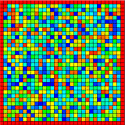 (b)
(b)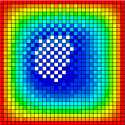 (c)
(c)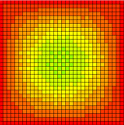
Figure 3. Convergence of the finite method for solving the Laplace
Heat Equation can be seen by visualizing the two-dimensional array
representing the heated surface.
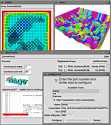
Figure 4. A DAQV session with a control client. A simple
two-dimensional data client and a three-dimensional data client both
represent the 2D array from the Laplace Heat Equation code.
Seismic Tomography
As part of a recent effort to build a domain-specific environment for
seismic tomography [8], the DAQV framework was used to both extract
and modify simulation data and control the program at runtime. As an
integral part of the interactive steering and visualization
environment, DAQV provided the data needed by marine seismologists
studying the formation and structure of volcanic mid-ocean ridges.
7.2 Framework Portability
As the primary derivative of a Ptools project, the DAQV reference
implementation is required to function on two platforms. However, the
definition of "platform" as it pertains to DAQV is somewhat
ambiguous. For most projects, a platform refers to a specific brand of
machine. For DAQV, though, that level of portability is trivially
achieved since we code to the HPF language, not the specific HPF
compiler. Thus, for example, in the case of DAQV using pghpf, we met
the Ptools portability requirement simply by demonstrating DAQV
running on an SGI Power Challenge (or workstation) and a Sun
workstation. Instead, for DAQV we identified three degrees of
portability: machine, compiler, and language. Machine portability
assumes use of a given compiler for a given language and refers to
DAQV's ability to be used on different computer hardware; compiler
portability assumes only a given language and refers to DAQV's ability
to be used with different compilation systems; and language
portability refers to DAQV's applicability to other language or
programming model targets. As discussed earlier, we view portability
as a means of validating our notion of a framework. As of this
writing, we have successfully demonstrated DAQV's portability in all
three degrees.
Machine Portability
DAQV was developed using The Portland Group's pghpf compiler [25] on
SGI workstations and Power Challenges. With no changes, DAQV will also
work on Solaris workstations. With only minor modifications, DAQV was
recently ported by the Cornell Theory Center to run with pghpf on an
IBM SP2. Initial tests on porting DAQV to pghpf on a Cray T3D also
look very promising.
Compiler Portability
DAQV has been ported with varying degrees of success to two other HPF
compilers. First, Cornell Theory Center attempted a port of DAQV to
IBM's xlhpf compiler that was only partially successful because of
limitations in the compiler. In particular, xlhpf does not yet support
HPF's INHERIT directive, which, as alluded to in Sections 6.3 and 6.4,
is necessary in the array access functions. The implication of this
was that the implementation of the array access functions was unable
to leverage HPF semantics and the xlhpf runtime support to carry out
data collection. Second, at a recent conference we also discovered
that DAQV worked without any modifications to the public domain
ADAPTOR/HPFIT compilation system [2, 3]. Future compiler targets may
include Applied Parallel Research (APR), DEC, and the D System/dHPF
compiler [1].
Language Portability
So far, two attempts at moving DAQV beyond HPF have been made and both
have been largely successful. First, DAQV was successfully ported to a
Fortran90/message passing code at Los Alamos National Laboratory
(LANL) [11]. A primary distinction between HPF and this programming
model is the lack of a global address space. That is, each node only
knows about its local elements, and access to remote values is
achieved through explicit message passing. This complicates our
ability to provide general array access functions. The approach that
was taken in this case was to create application-specific array access
functions that understand the data decomposition and substitute them
for the default ones in the DAQV library. A general port of DAQV to
this model could support commonly used distributions and
simultaneously support user-defined access functions. The second
language target was the POOMA/C++ application framework under
development at LANL [27]. In this case, robust language semantics
allowed us to create generic access functions for POOMA Field objects
analogous to those used with HPF. While a full port to POOMA has not
been completed, the concept has been proven and demonstrated [10].
7.3 Data Client Portability
DAQV also exhibits another, orthogonal notion of portability with
respect to its data clients. A DAQV data client is portable in that it
need not be tied to a specific DAQV implementation. The DAQV data
protocol defines a standard interface through which array data is
formatted and delivered to external clients regardless of the system
(e.g., HPF, Fortran90, or C++) from which the data originates. In its
most general form, a DAQV data client need only understand this data
format. Currently, this format is a simple row-major ordering of the
data prefaced by a small amount of metadata (as described in Section
6.2). In the future, DAQV will include support for standard data
formats like HDF to extend even further the interoperability of the
DAQV framework.
(a) 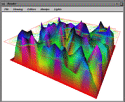 (b)
(b)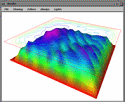 (c)
(c)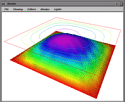
Figure 8. Displays created within IRIS Explorer can take advantage of
existing, advanced scientific visualization capabilities. For example,
the visualization program in Figure 7 superimposes contour lines over
a 3D displaced grid surface to create the displays in (a), (b), and
(c). The data source is the Laplace Heat Equation program discussed in
Section 7.1 and shown in Figures 3 and 4.
8 Conclusions and Future Work
In its current form, DAQV should be regarded as a reference
implementation that demonstrates functionality, specifies components
and their system requirements, and defines APIs and transport
protocols. In fact, being the primary derivative of a Ptools project,
the reference implementation serves as a prototype for vendors to
evaluate and potentially adopt.
Availability
The DAQV reference implementation, ported implementations,
documentation, and more detailed information can be found on our web
pages at http://www.cs.uoregon.edu/~hacks/research/daqv/.
Acknowledgments
The authors would like to thank the Parallel Tools Consortium, Cornell
Theory Center, Los Alamos National Laboratory, The Portland Group,
Inc., and the members of the ParaDucks research group at the
University of Oregon.
References
Last modified: Tue Dec 7 09:47:12 PST 1999
Steven Hackstadt /
hacks@cs.uoregon.edu



